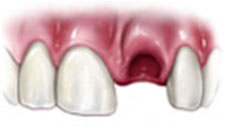Traumatic Dental Injuries
Traumatic dental injuries can occur any time there is physical activity, or as a result of an accident. Teeth can sustain damage in two ways: 1. A physical damage to the tooth (i.e. a fracture in tooth, a dislocated tooth, or an avulsed tooth) 2. Damage to the underlying pulp (nerve) of the tooth. Endodontists are highly trained specialists to manage most of these traumatic injuries. The types of traumatic injuries and the recommended treatments are listed below:
Chipped or Fractured Teeth
Chipped teeth account for the majority of all dental injuries. Most chipped or fractured tooth crowns can be repaired either by reattaching the broken piece or by placing a tooth-colored filling. If a significant portion of the tooth crown is broken off, an artificial crown or “cap” may be needed to restore the tooth.
Injuries in the back teeth often include fractured cusps, cracked teeth, and the more serious split tooth. If cracks extend into the root, root canal treatment and a full coverage crown may be needed to restore function to the tooth. Split teeth may require extraction.
 Dislodged (Luxated) Teeth
Dislodged (Luxated) Teeth
During an injury, a tooth may be pushed sideways, out of, or into its socket. Your endodontist will reposition and stabilize your tooth. Root canal treatment is usually needed for permanent teeth that have been dislodged and should be started a few days following the injury.
Knocked-Out (Avulsed) Teeth
Sometimes a traumatic incident can completely knock a tooth out of its socket. It is imperative to see a dentist within an hour of the accident to increase the chances of successful treatment. Gently rinse tooth, but do not scrub it. The tooth should be placed in a suitable storage medium in the interim. The ideal place is in the patient’s mouth under the tongue, to ensure the tooth does not dry out. Other acceptable storage media are: contact lens solution and non-skim milk. The dentist will reinsert the tooth back into the socket and place a soft splint to hold in place. Root canal treatment is required within 7-10 days.
Fractures
A traumatic injury may also result in jaw or root fracture. Obtaining a CBCT volume of the area allows us to determine the location and extent of the fracture. Sometimes, stabilization with a splint is required for a period of time. With respect to root fractures, the location and extent of the fracture may determine the long-term prospects of the tooth.

